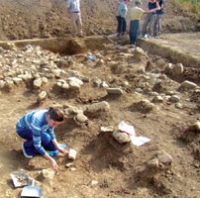|
 Institute of archeology and ethnography of SO RAN excavations were instrumental in the discovery of a new type of early human not known before, who inhabited the territory of Altai Krai about 30-40 thousand years ago, at the same time with Neanderthals and people of modern physical type, as announced by the communications department of SO RAN to Academ.info. This extremely significant find was made during quite ordinary circumstances, as the leader of the excavations, vice-director of IAET SO RAN in science, Doctor of historical sciences, Mikhail Shunkov, explained. Institute of archeology and ethnography of SO RAN excavations were instrumental in the discovery of a new type of early human not known before, who inhabited the territory of Altai Krai about 30-40 thousand years ago, at the same time with Neanderthals and people of modern physical type, as announced by the communications department of SO RAN to Academ.info. This extremely significant find was made during quite ordinary circumstances, as the leader of the excavations, vice-director of IAET SO RAN in science, Doctor of historical sciences, Mikhail Shunkov, explained.
“We were working in Denisova peshchera (Denis’ cave), just as we have been doing for the past 20 years, and together with some archeological materials, we found a small bone of ancient human, which was associated with Early Paleolithic stone tools. Those strata are dated 30-40 thousand years before present.”, said Mikhail Shunkov.
The scientists elucidated that the bone in question is a finger-bone of a child, most likely a girl, aged between 5-7 years. Subsequently the specimen was submitted to the archeologists of the Max Planck Institute of Evolutionary Anthropology in Germany.
It took some time to isolate the mitochondrial DNA from the fossil, but the resultant data became sensational. DNA analysis showed that there were major differences in the genetic code of the new find from the humans of modern physical type as well as from the Neanderthals.
Relatively recently, even 20-30 years ago, it was thought that the course of human evolution was gradual and smooth, and that Neanderthals appeared to be the precursors of modern humans, and that they, in turn, also had their ancestors. About 10 years ago, mostly due to new technologies for study of fossil DNA, it became clear that these were actually two separate lineages, and the Neanderthals were not ancestors of modern humans but a blind-end evolutionary branch, even though they both existed side by side for a prolonged period of time.
“The data that now have been obtained, even though not yet final, point to the existence of a third type, which is now designated by a temporary name of “Altai human”; this type is not an ancestral form to either of the other two. Before we obtained these data, we supposed that two types of ancient humans lived in Altai, and the artifacts which we have been finding in Denisova peshchera we attributed to Homo sapiens,” commented Mikhail Shunkov.
The Siberian archeologists also found a number of interesting artifacts, which, until now, were believed to be a trademark of the appearance of culture of humans of modern physical type. First and foremost, these are objects of symbolic meaning, for example, decorations – including a stone bracelet and a ring carved of marble.
“These finds were made with the use of technological approaches (polishing the stone, drilling, grinding) which have been traditionally believed to be characteristic of much later time, and nowhere in the world have they been known to be used so early in the Paleolithic. Having documented the presence of these artifacts in Denisova peshchera, we have been ascribing them to the progressive form of human of modern physical type, but now it became obvious that everything really is radically different,” said the scientist.
The scientists suppose that “Altai human” came from Africa, apparently having separated from the common stem
Homo about one million years ago. Neanderthals and humans of modern physical type separated significantly later, about 500 thousand years ago. What the mutual interactions of these three types of ancient humans were like is something that the archeologists will have to study yet.
|
|
